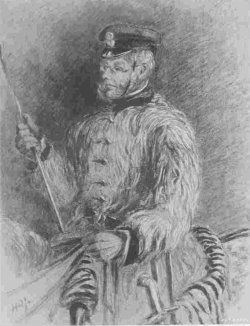George Broadfoot facts for kids
Quick facts for kids
George Broadfoot
|
|
|---|---|
 |
|
| Born | 21 March 1807 Kirkwall, Scotland, United Kingdom |
| Died | 21 December 1845 (aged 38) Ferozeshah, Sikh Empire |
| Allegiance | East India Company |
| Service/ |
Madras Army |
| Rank | Major |
| Battles/wars | First Anglo-Afghan War First Anglo-Sikh War |
| Awards | Companion of the Order of the Bath |
George Broadfoot was a brave Scottish army officer. He worked for the East India Company in India. This company was very powerful and important in India a long time ago. George Broadfoot was a Major in the Madras Army, which was part of the East India Company's forces. He was born on March 21, 1807, and sadly died on December 21, 1845, during a battle. He was also given a special award called the CB.
Contents
Broadfoot's Early Life and Career
Growing Up and Joining the Army
George Broadfoot was born in Kirkwall, a town in Orkney, Scotland. He was the oldest son of Reverend William Broadfoot. When he was ten, his family moved to London, where he went to school.
In 1825, when George was 18, he joined the East India Company as a cadet. This meant he was training to become an officer. He arrived in India in January 1826. His first job was as an Ensign (a junior officer) in the 34th Regiment of Madras Native Infantry. While traveling to India, he became good friends with Colin Mackenzie.
Travels and Return to India
After serving for seven years in Madras, India, Broadfoot went back to England. He stayed there for five years. During this time, he traveled around Europe, visiting France, Germany, and Italy. Before returning to India, he worked for 13 months at a military school called Addiscombe Military Seminary. He went back to India in 1838 and joined the supply department of the Madras Army.
Adventures in Afghanistan
Journey to Kabul
When the First Anglo-Afghan War began, George Broadfoot was sent to the northern parts of India. Even though he had no experience there, he was given an important job. He was put in charge of protecting the families of two important leaders, Shah Sujah and Zaman Shah. He had to escort them from Delhi to Kabul.
This journey was very dangerous. They had to travel through Punjab, which was in a state of disorder after the death of its ruler, Ranjit Singh. The group was often in danger from soldiers and bandits.
Defending Jalalabad
Once they reached Kabul, some of Broadfoot's escort became a special group of engineers called sappers and miners. Broadfoot led them. In October 1841, they marched with Sir Robert Sale's army from Kabul to Jalalabad. Broadfoot was praised for his bravery in battles against the Afghans on the way.
At Jalalabad, Broadfoot became the main engineer for the fort. He quickly fixed the town's defenses, which were in bad shape. He used Gurkha soldiers as engineers because he didn't have his own sappers and miners. During the siege of Jalalabad by the Afghans, Broadfoot (who was now a Captain) and his friend Henry Havelock played a key role. They stopped the army from giving up, which many officers had decided to do. Broadfoot was badly wounded in one of the fights outside the fort.
After the War
Later, Broadfoot joined General Pollock's army, which went back to Kabul to get revenge. He again showed great bravery in battles. After the war, he was given the Companion of the Order of the Bath award. He was then made the Commissioner of Moulmein, a province where he worked to fix problems with corruption.
Working in Punjab
In 1844, the Governor-General, Sir Henry Hardinge, gave Broadfoot a very important job. He became the Agent of the North-West Frontier. This was one of the most respected positions in India at the time. He was based in Punjab, which was still very chaotic. His job was to keep his leaders informed about what was happening there. This was important in case the British army needed to get involved in a war.
In May 1845, Broadfoot went to Shimla to rest because he was working too hard and felt stressed. Around the same time, a disease called cholera spread in Punjab. This made the Sikh army less aggressive and reduced the violence.
In August 1845, Broadfoot received a message from Gulab Singh. Gulab Singh wanted the British to start a rebellion against the Sikhs. He offered his help if he could get money and keep his lands. Broadfoot decided not to reply to this offer.
Broadfoot's Final Battle
The First Anglo-Sikh War
Towards the end of 1845, the First Anglo-Sikh War started. George Broadfoot was present at two major battles: the Battle of Mudki and the Battle of Ferozeshah.
At the Battle of Ferozeshah on December 21, 1845, Broadfoot was shot in the heart and killed. He was first wounded in both legs and fell off his horse. He quickly got back on his horse, but then he was shot through the heart and arm.
A Hero Remembered
Sir Henry Hardinge, the Governor-General, was very sad about Broadfoot's death. He wrote about it in his report on the battle: "It is now with great pain that I have to record the irreparable loss I have sustained, and more especially the East India Company's service, in the death of Major Broadfoot... He was brave as he was able in every branch of the political and military service."
The Governor-General organized and attended Broadfoot's funeral. George Broadfoot was buried at Ferozepur, next to Sir Robert Sale. The horse Broadfoot was riding when he died was also shot twice. But it recovered and was kept by Hardinge. Broadfoot's friend, Henry Havelock, later named his son George Broadfoot to honor him.

